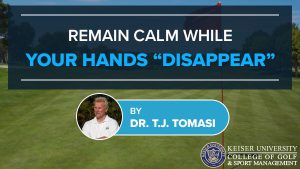Remain Calm While Your Hands “Disappear”

By Dr. T. J. Tomasi, Keiser University College of Golf Senior Faculty and Director of Research
You hear a lot about the importance of hand-eye coordination, but what happens when your visual tracking system loses track of your hands? In my experience, one of the things that good players conquer while average players never do is the failure of the brain to track their hands after they leave their field of vision. While you may not be consciously aware of it, your brain can easily keep track of your hands when they’re in front of you at address, and it can effortlessly follow them using peripheral vision during the takeaway. But as your hands approach the 9 o’clock position (the ball is at 6 o’clock), they exit your visual field, forcing your brain to rely solely on its network of feel sensors scattered throughout your body.
Hands in Golf Swing
Keeping track of your hands is important because they are the only contact you have with the club, and although you may not consciously focus on them as the “feel center” of your swing, they are instrumental in tracking the clubhead. Basically, your hands are the clubhead.
Think of it this way: You start at address with your two most effective tracking systems on full go (visual and feel), and about 9 o’clock, you’ve cut your tracking information by half as your hands leave your field of vision. This is why the transition from 8 o’clock to 9 is a major breeding ground for swing error, and why, unless you practice or play a lot, feel alone is such a will-of-the-wisp foundation on which to build a consistent, repeating swing.
So it’s not unreasonable to focus some of your practice on the danger zone between 8 and 9 o’clock to make sure that the shock of your hands disappearing from your visual radar screen doesn’t trigger a code red emergency signal — the kind of warning that causes those disruptive lunges and lurches at just the wrong time. When you watch a good player, even one with a funky swing, what you are seeing is someone who has learned to remain calm when his/her hands (and by extension the clubhead) leave the visual tracking screen. The key to calmness is expectation and rehearsal, which means that you must practice the transition so much that you correctly anticipate what’s going to happen so that when it does, your training carries the day.
Golf Takeaway Drills
I recommend the following drill, which you should do 60 times a day for 21 consecutive days to insert it into your unconscious competence (i.e., habit): from your normal address position close your eyes and swing your hands/club back to about waist high (8 o’clock). Since you haven’t cocked your wrists yet, when you open your eyes you should be able to see both your hands and the clubhead forming a straight line. This is the end of your takeaway, and the shaft should be parallel to the target line. If you are out of position, realign, then close your eyes again and let your brain register the feeling.
As soon as you can repeat this consistently, go to the 9 o’clock position, where your hands have cocked so that the shaft and your forearm form a 90-degree angle, with the butt of the club pointing at the target line (aka “on plane”). When you can repeat this correctly, start practicing; i.e., 60 times per day for 21 days in a row. Now you are ready to take it to the course!
If you’d like to study with Dr. Tomasi and other PGA Master Professionals, contact The College of Golf today.














